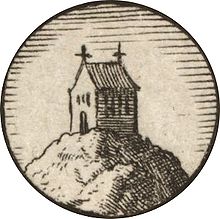Evangelical Catholic
[1] Various apostolates and religious orders exist, which herald Evangelical Catholic principles within Lutheranism.
Lutheran Protestantism differs historically from most other kinds of Protestantism in that Lutheranism is the only historical Protestant denomination that confesses belief in three sacraments: regeneration in Holy Baptism, Confession as the sacrament of Absolution, and the Real Presence of Christ in Holy Eucharist.
[6][7] In Anglicanism and Methodism, two other Protestant traditions, there has also been a sacramentalism similar to that in orthodox Lutheranism, especially in the high church movement.
The Book of Concord states, contrary to "Enthusiast" belief, that salvation can be received only through the means of grace: God's Word and sacraments.
[8] The Augsburg Confession stresses that "in doctrine and ceremonies nothing has been received on our part against Scripture or the Catholic Church.
The evangelical feature of Lutheranism is justification by faith, as defined by Law and Gospel and simul iustus et peccator.
In the Lutheran tradition, evangelical (evangelisch) refers to the gospel, with the specific meaning of "grace centered".
Gnesio-Lutherans such as Joachim Westphal and Andreas Musculus had a "high" understanding of the sacraments, and therefore were strongly opposed to any compromise with Calvinism and Zwingliism, as well as with Roman Catholic doctrine.
In the era of Lutheran orthodoxy, theologians Martin Chemnitz and Johann Gerhard (especially in his Confessio Catholica) made extensive use of patristic sources.
Answer: "The whole number of those who have, teach and confess the entire doctrine of the Word of God in all its purity, and among whom the Sacraments are duly administered according to Christ's institution."
Only that one is the true visible Church which teaches and confesses the entire doctrine of the Word of God in all its purity, and in whose midst the Sacraments are duly administered according to Christ's institution.
Mother Basilea Schlink established the charismatic Evangelical Sisterhood of Mary in Darmstadt, which contains the motherhouse where the Lutheran nuns reside.
"[18] As such, "Lutheran places of worship contain images and sculptures not only of Christ but also of biblical and occasionally of other saints as well as prominent decorated pulpits due to the importance of preaching, stained glass, ornate furniture, magnificent examples of traditional and modern architecture, carved or otherwise embellished altar pieces, and liberal use of candles on the altar and elsewhere.
[14] The Beeldenstorm, a large and very disorderly wave of Calvinist mob destruction of images and church fittings that spread through the Low Countries in the summer of 1566 was the largest outbreak of this sort, with drastic political repercussions.
[21] This campaign of Reformed iconoclasm "provoked reactive riots by Lutheran mobs" in Germany and "antagonized the neighbouring Eastern Orthodox" in the Baltic region.
"[23][24] The Smalcald Articles, a confession of faith of the Lutheran churches, affirm the doctrine of the perpetual virginity of Mary.
[29] The Wreath of Christ, also known as the Pearls of Life, is a set of prayer beads developed by the Swedish Evangelic-Lutheran bishop Martin Lönnebo.
"[33] Traditions, such as episcopal polity and apostolic succession are also maintained and seen as essential by Lutherans of Evangelical Catholic churchmanship; the Church of Sweden for example teaches that "Since this ordinance was very useful and without doubt proceeded from the Holy Ghost, it was generally approved and accepted over the whole of Christendom.
The form of Church government practiced by the LC-MS and ELCA (and almost all other expressions of American Lutheranism) was condemned by Fr.
Luther when Philip of Hesse (perhaps the most prominent Prince within the Reformation Movement next to the Elector of Saxony), prevailed upon the synod at Hamburg in 1526 to adopt a form of congregational government ordered by a constitution accepted by all.
Such polity (i.e., congregationalism) undermines The Gospel and usually leads to the distorted view that, because The Faithful are a royal priesthood (I Pet.
[3][1] In 1976, Joseph Ratzinger, later Pope Benedict XVI, suggested that the Augsburg Confession might be possible to recognise as a Catholic statement of faith.
The first is a strong theological and devotional emphasis on the Christian scriptures, often holding to a prima scriptura position regarding the Deposit of Faith.
A personal need for interior conversion is the third defining mark, and, consequently, the fourth is a deep commitment to evangelization.
Increasingly, the Roman Catholic Church is appropriating the evangelical witness of the recent popes and their encyclicals, especially Pope Paul VI's Evangelii nuntiandi (On Evangelization in the Modern World), John Paul II's Redemptoris missio (The Mission of the Redeemer), and the Congregation for the Doctrine of the Faith's Declaration Dominus Iesus (The Lord Jesus), for which Pope Benedict XVI was primarily responsible, when he was previously Prefect of the Congregation.
Already earlier, there was an evangelical revival in the Roman Catholic Church in Germany, involving Boos, Gossner and Feneberg.
In England, Ulric Vernon Herford (1866–1938), irregularly consecrated as Mar Jacobus, Bishop of Mercia & Middlesex, founded The Evangelical Catholic Communion.
According to Harper's New Monthly Magazine: The various Protestant sects can not constitute one church because they have no intercommunion...each Protestant Church, whether Methodist or Baptist or whatever, is in perfect communion with itself everywhere as the Roman Catholic; and in this respect, consequently, the Roman Catholic has no advantage or superiority, except in the point of numbers.
[53] It simply means that body of Christian believers over the world who agree in their religious views, and accept the same ecclesiastical forms.






